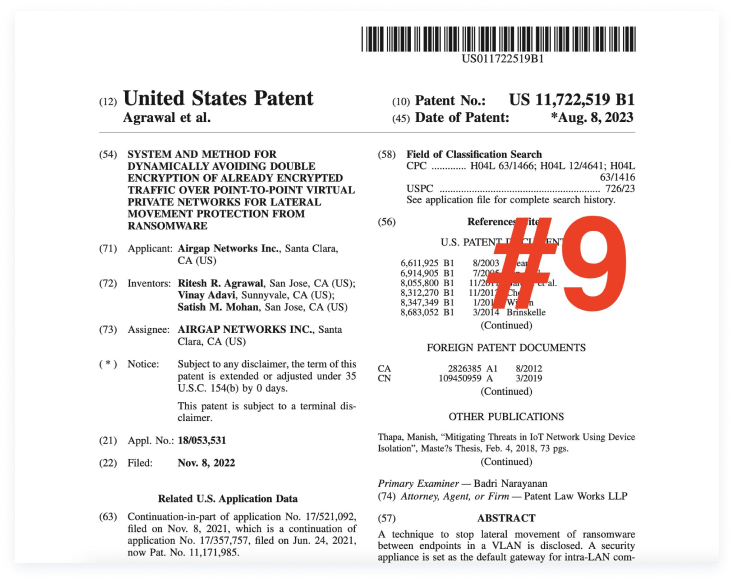Airgap Networks is thrilled to announce the granting of our 9th patent, US 11,722,519 B1, a pioneering "System and method for dynamically avoiding double encryption of already encrypted traffic over point-to-point virtual private networks for lateral movement protection from Ransomware." This cutting-edge technology dovetails seamlessly with the Zero Trust framework, enriching its capability to thwart ransomware's lateral movements within VLANs. As we dive deeper into the underpinnings of Zero Trust and its transformative potential in cybersecurity, this patented approach showcases a major stride in equipping organizations with a nimble, resilient defense mechanism against ransomware attacks.
In the unceasing arms race between cybersecurity experts and ransomware attackers, one strategy has emerged as a beacon of hope: the Zero Trust model. In this blog, we'll explore a groundbreaking technique designed to bolster Zero Trust by preventing ransomware's lateral movement within a VLAN. By seamlessly integrating this technique with a Zero Trust approach, organizations can forge a formidable defense against ransomware.

The Zero Trust Paradigm
Zero Trust is a cybersecurity framework that challenges the traditional notion of trust within a network. In a Zero Trust model, no entity is trusted by default, even if it's inside the corporate network. Instead, trust must be continually verified. The ultimate goal is to minimize the attack surface and secure all network resources, devices, and user identities.
The Zero Trust Ransomware Defense Technique
This innovative technique aligns perfectly with the Zero Trust model's principles and enhances its effectiveness. Here's how it achieves this synergy:
Security Appliance as Zero Trust Gateway:By designating the security appliance as the default gateway for intra-LAN communication, the Zero Trust model's core tenet of "never trust, always verify" is realized. All communication is scrutinized, and no device is implicitly trusted.
Continuous Endpoint Monitoring:The security appliance remains vigilant, continually monitoring message traffic within the VLAN. This aligns with the Zero Trust principle of continuous monitoring and verification, ensuring that trust levels are never assumed.
Attribute-Based Threat Detection:In keeping with Zero Trust's emphasis on identity and context-based access control, this technique identifies ransomware attributes within network traffic. It doesn't rely solely on known signatures but rather scrutinizes data access patterns and other behavior indicative of ransomware activity.
Countering Evasion Attempts:Zero Trust extends beyond the network perimeter, and so does this technique. It actively detects and thwarts evasion attempts by ransomware, ensuring that trust is never granted, even in the face of sophisticated attacks.
Endpoint Quarantine:When a compromised device is detected, it's immediately quarantined. This embodies the Zero Trust principle of "least privilege access" by isolating the threat and reducing the attack surface.
In the unceasing arms race between cybersecurity experts and ransomware attackers, one strategy has emerged as a beacon of hope: the Zero Trust model.
Benefits of Zero Trust Integrated Ransomware Defense
The integration of this innovative ransomware defense technique with a Zero Trust strategy offers profound benefits:
Enhanced Security Posture:Zero Trust principles demand constant vigilance and verification, and this technique epitomizes that ethos. Together, they provide a formidable defense, ensuring that trust is earned and never assumed.
Minimal Attack Surface:The isolation of compromised devices aligns perfectly with Zero Trust's goal of minimizing the attack surface. Even if one device is compromised, the damage is contained.
Rapid Threat Response:Automation in response to detected threats ensures quick reactions, in harmony with Zero Trust's focus on continuous monitoring and immediate response.
Adaptive to Evolving Threats:The use of advanced threat detection algorithms means that this integrated approach adapts to evolving ransomware tactics, staying ahead of the threat landscape.
The patent abstract describing this innovative technique to halt the lateral movement of ransomware within VLANs represents a significant stride forward in cybersecurity. As ransomware attacks continue to surge, organizations need proactive, adaptive, and effective defenses. This method, with its focus on identifying ransomware attributes and preventing its spread, offers newfound hope in the ongoing battle to protect valuable data and network resources. While the specifics of the patented technology may remain confidential, its potential to reshape the cybersecurity landscape is undeniably exciting.
Conclusion
In the age of relentless ransomware attacks, a Zero Trust approach to cybersecurity is a beacon of resilience. By seamlessly integrating an innovative ransomware defense technique into the Zero Trust framework, organizations can realize an unyielding security posture. Trust is no longer an assumption; it's a privilege that is continually verified. In a world where trust is earned, not given, the path to cyber resilience becomes clearer and more attainable.
